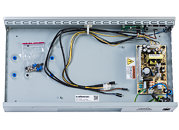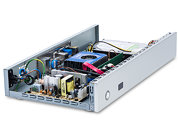Monday, December 16th 2013
Alkeron Rolls Out Class-E 211 Mini-ITX enclosure
Alkeron Hardware announced its new Class-E 211 Mini-ITX enclosure - a minimalist enclosure for low powered Mini-ITX boards intended primarily for multimedia use. The case features sleek design with brushed aluminum front panel. An internal power supply eliminates need for external "brick" reducing a wiring mess. The PSU delivers 65W of power, enough to power an Intel Atom or AMD APU based Mini-ITX board and a single 3.5" or 2.5" hard drive.
A built-in USB IR receiver works out of the box with majority remote controls and operating systems. The case was designed with Hi-Fi component form factor in mind and it fits nicely in Audio/Video rack. The case works well in fanless configuration delivering sufficient airflow through openings at the top and the rear - big plus for multimedia application. There an opening for optional 40mm exhaust fan at the real for extra cooling if required. The case was safety certified for US and Canada by UL labs. The case is currently available from manufacturer's online store as well as on Amazon and eBay. It will be arriving at retailers in early 2014 with MSRP US$179.
A built-in USB IR receiver works out of the box with majority remote controls and operating systems. The case was designed with Hi-Fi component form factor in mind and it fits nicely in Audio/Video rack. The case works well in fanless configuration delivering sufficient airflow through openings at the top and the rear - big plus for multimedia application. There an opening for optional 40mm exhaust fan at the real for extra cooling if required. The case was safety certified for US and Canada by UL labs. The case is currently available from manufacturer's online store as well as on Amazon and eBay. It will be arriving at retailers in early 2014 with MSRP US$179.



7 Comments on Alkeron Rolls Out Class-E 211 Mini-ITX enclosure
Would have been nice (IMO) to have had a 2nd hard drive capability, maybe a SSD for boot and a big capacity spinner for storage.
I'd like to see a shot with all the PSU wires in place to see how they do the 24-pin.
They all require a much smaller 4-pin connector while some others used to require a simple "molex" connector.
(then again,... i could be wrong)
Most mini-ITX boards still require a 24-pin, and the board they are using in the press photos is by MSI and definitely requires a 24-pin.
Here is an example. We had to use picoPSU-120 with MSI E350IA-E45 board which is rated at 120W because picoPSU-90 couldn't handle it even though the board itself takes only 25-28W and PSU is rated at 65W.